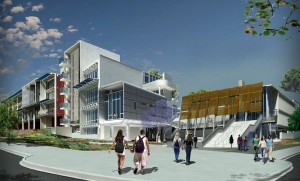College Construction Boom San Diego Community College District’s $1.6 billion construction bonds program is creating jobs and transforming the campuses

By Manny Cruz
More than a quarter of the nation’s construction work force is unemployed, according to the Associated Builders and Contractors trade group, but you wouldn’t know it by what’s happening on the campuses of the San Diego Community College District.
The district is carrying out a $1.6 billion construction program that so far has created more than 5,500 jobs for local builders and enhanced the educational opportunities for students in the district’s academic and vocational programs, not to mention the gleaming, state-of-the-art facilities that have been built or are on the drawing boards.
And it’s going to continue for the next five years.
For this, the district and local construction industry can thank the voters, who approved a $685 million bond measure in 2002 and an $870 million measure in 2006 — known as Proposition S and N, respectively — to pay for the massive upgrade of the district’s educational facilities.
“Propositions S and N have literally transformed our campuses,” says Dr. Constance M. Carroll, district chancellor. “We have already opened a number of extraordinary new buildings with state-of-the art instructional equipment. As a result, our students are extremely well educated and well prepared either to transfer to universities or to enter the workforce.”
The near-gargantuan task of managing the district’s building program — to date the bonds have funded about 30 projects from a master list of about 80 — belongs to Gafcon, a $25 million construction consulting and management company based in San Diego, and to Pam Gaffen, its president and chief operating officer. Gaffen, 54, a diminutive woman with a high regard for client service and equal opportunity in the industry for women, got her start in construction in the mid-’70s— a time when females were not well represented.
But times have changed. Gafcon employs about 110 people, half of whom are female. “It’s from a conscious effort to recruit women,” says Gaffen, who established the company in 1987 with her husband, Yehudi “Gaf” Gaffen.
Ursula Kroemer, communications director for the college district’s construction bond program, admires Gaffen’s leadership style. “Pam goes out of her way as a CEO to mentor and support women, and encourage professional development,” she says.
Gafcon has 21 people working full-time in the community college district’s construction program in a variety of areas, including budget and financial reporting, contracts, contractor prequalification, campus project managers, assistant managers and project-specific construction managers. “We’ve got quite a big team out there,” says Gaffen. “It’s a billion-dollar program with lots of work over many years. We’ve got a lot of work to go.”
The projects that Gafcon manages run the gamut from the construction of new energy-efficient academic and vocational buildings and parking facilities to the renovation of campus structures, the acquisition of land, consolidation of existing programs, and roadwork and seismic retrofits. (See sidebar for a list and description of the projects.)
“The kinds of buildings represent an incredibly diverse range of facilities and program needs,”says Kroemer. “It’s almost a ‘name the project’ and I can say, yes, we have or will have a facility to meet that instructional or career training purpose.”
The most expensive construction project of the 80-plus projects is the $117 million, 200,000-square-foot Math and Science building to be built at Mesa College, which is currently in the design stage. The four-story building will include classrooms, lecture rooms, labs for scientific experiments, computer labs and space for faculty and administrative staff. Construction is expected to start in February 2011 and completed in January 2013.
Last August, a new, $28.9 million Allied Health Building was completed at Mesa, offering 50,000 square feet of training facilities and classroom space for five health care fields in a three-story structure. Margaret Fickess, director of the dental assistant program, oversees student instruction in spacious laboratories filled with brand new, state-of-the art equipment. Here, students training to become dental assistants can learn a variety of procedures and actually practice those procedures on family, friends or classmates — under supervision, of course.
City College Campus
At City College, once likened to a prison because of its drab appearance and worn-out facilities, has taken on the look of a vibrant, modern urban campus. The Propositions S and N program has provided $25.5 million for renovations to create a Learning Resource Center, Academic Success Center and enhanced gymnasium facilities. Still to come are a $72.5 million Career Technology Center, twin Arts & Humanities/Business Technology buildings costing $85 million, an $83.5 million classroom bulding, a $54.8 million science building and $12.2 million for upgrades to street sewer and storm drains, the central plant and telecommunications infrastructure. At work’s end, City College will have seven new teaching and learning facilities and seven major renovations to serve an eventual student enrollment of 25,000.
Miramar College
Miramar College, the newest campus in the San Diego Community College District — it opened in 1978 — has seen the completion of 13 construction and upgrade projects. Yet to come are $121.1 million in new construction and expansion projects, including a $48.3 million Library Learning Resource Center, a $33.2 million Student Campus Center and Cafeteria/Bookstore, an $8.9 million Aviation Maintenance Technology Center and a $13.8 million parking structure and police substation. The college, describe by Community College Week as the 16th fastest growing middle-sized community college in the nation, is expected to grow to a student population of 15,000 by 2015, up from 9,000-plus today.
Continuing Education
The community college district maintains six Continuing Education campuses — Centre City, César Chavez, the Educational Cultural Complex, Mid-City, North City and West City. Propositions S and N funds have been allocated to expand and modernize facilities at all six. Completed projects include an $18 million, two-story building on the West City campus devoted to hospitality and consumer science, and a new $35 million Skill Center at the Educational Cultural Complex that will have classrooms for automotive repair, upholstery, reprographics services and business information technology.
Future Continuing Education projects include the construction of a new, two-story, 40,000-square-foot classroom building and a 300-space parking structure at the North City campus — total value of $50.7 million, including land acquisition costs. Also in the works is a $48.7 million, 70,000-square-foot building to consolidate current programs at the Cesar Chavez and Centre City campuses. The Linda Vista campus at Mesa College will get a new, $19.2 million building to consolidate programs now being held in temporary facilities and the Educational Cultural Complex is due for a $16.3 million expansion of the main building to replace bungalows, modular classroms, labs and support rooms that are not connected to the building.
West City Campus
Completion of the West City campus last year triggered a waiting list of students wanting to get into the culinary arts and other programs offered in the Hospitality and Consumer Sciences facilities. “Its totally state-of-the-art with ample space for instruction and collaborative learning,” says Kroemer. “Students comment on how much more room there is, how comfortable the building is and how much the natural lighting helps. I’ve had several professors notice that not only are they feeling more productive and more engaged with their students in this new environment, they also notice their students are much more productive.”
SharePoint 360
Pam Gaffen brings a unique technological element to the Propositions S and N-funded program in the community college district from a company she founded three years ago. SharePoint 360 provides a Microsoft product, an Internet portal site that is used in running the extensive program, from database tools to document management and reporting. “Everyone in the program — from construction managers to project superintendents to even the board of trustees of the district and Citizen Oversight Committee members are connected in this system and can store a variety of documents and materials essential to their respective projects,” says Ursula Kroemer, communications director for the bonds program. “It’s a great way to connect people who serve different functions in different offices and aren’t connected to the same server.”
With the SharePoint 360 system, the district vice chancellor or any construction manager can go into his or her section of the portal, query something, such as change order aging rates, and within seconds the database is tapped into and a report is produced and sent back as an e-mail. Safety inspectors can use a hand-held device when they visit a site, take pictures and have them uploaded to the portal, saving them valuable time.
According to Gaffen, the SharePoint 360 system is not only being used in the community college district but is sold to a variety of other businesses and agencies, including NASA and Blue Cross-Blue Shield. “We customize it for each client,” she says. She is CEO of the company. Her son, Joshua Gaffen, 28, is director of delivery for the firm. (The Gaffens also have a daughter, Shayna Gaffen, 24, who is an art director for a gallery in Los Angeles.)
The Gafcollege
Besides managing the community college district’s bonds program, Gafcon provides a program within the company that allows employees to share their knowledge with other employees in a formal setting. It’s called “Gafcollege,” once-a-week sessions where, according to Gaffen, “our best people teaches our staff different things in the construction industry.” If an employee is interested, he or she can use the sessions as a stepping-stone to promotion. Gaffen says about 10 percent of her staff have been promoted from within, partially as a result of their involvement in Gafcollege.
Gaffen’s rise to the top in the construction industry didn’t come without some resistence from men in the industry. “I had to overcome some barriers,” she says. “I was treated like the wife of my partner (her husband), by men who thought I should be at home folding the laundry. But I’m pretty tough. I’m not going to let any man push me around in the workplace. At the end of the day, I’m responsible for the profitability of the company and its overall operations.”
Gaffen’s advice to women interested in pursuing a career in the industry: “You have to get beyond the woman thing and do what you are passionate about. Stay ahead of the curve. For us (at Gafcon), it was embracing technology. You just have to follow your dreams and pursue what you want to pursue. You connect with others and don’t let them dominate you.”

